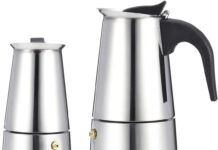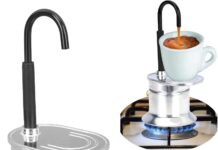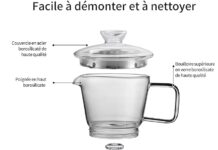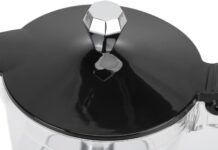Coffee lovers know the importance of a perfectly brewed cup, and for those who swear by their Bialetti coffee makers, getting that perfect cup means taking care of every little detail. But have you ever wondered how often you should be changing the filter on your beloved Bialetti? In this article, we will explore the answer to this question and unravel the secrets behind maintaining the optimum performance of your Bialetti coffee maker. So, grab your favorite mug, sit back, and let’s discover the filter-changing routine that will elevate your coffee experience to new heights.
Factors that Determine Filter Replacement Frequency
When it comes to maintaining our coffee-making equipment, one often overlooked aspect is the regular replacement of filters. However, the frequency at which we need to change filters can vary depending on several factors. In this article, we will explore the key factors that determine filter replacement frequency and provide tips to extend the lifespan of our filters.
Coffee Consumption
Regular versus Occasional Use
The frequency of filter replacement is greatly influenced by how often we use our coffee maker. For those who use it daily, either in the morning or throughout the day, the filters may need to be replaced more frequently. On the other hand, occasional use may allow us to stretch the lifespan of our filters.
Number of Cups Brewed per Day
The number of cups we brew per day also impacts the filter replacement frequency. If we frequently brew multiple cups, the filter will endure more wear and tear, resulting in faster clogging and decreased performance. Consequently, those who brew a high volume of coffee daily may need to replace the filter more often compared to those who brew just one or two cups.
Water Quality
Tap Water versus Filtered Water
The quality of water used in our coffee-making process is another important factor to consider. If we use tap water, which often contains minerals and impurities, our filter will be subject to more sediment buildup and clogging. However, if we opt for filtered water, our filter may last longer due to the reduced impurities suspended in the water.
Hard Water versus Soft Water
The hardness or softness of the water we use can also affect the filter replacement frequency. Hard water, which has a higher mineral content, can lead to more rapid scaling and clogging of the filter. Conversely, using soft water, which has a lower mineral content, may result in a longer lifespan for our filters.
Grind Size
Coarse Grind versus Fine Grind
The grind size of coffee beans influences the rate at which the filter becomes clogged. Coarse grinds tend to have larger particles, allowing water to flow more freely through the filter. In contrast, fine grinds have smaller particles that can easily accumulate and block the filter. Therefore, those who prefer a finer grind may find themselves replacing the filter more frequently.
Influence on Filter Clogging
In addition to the grind size, the overall amount of coffee grounds used per brew can also impact the clogging of the filter. Using an excessive amount of coffee grounds, commonly known as overpacking, can overload the filter, causing it to clog more quickly. It is important to find the right balance and avoid using more coffee grounds than necessary to help prolong the lifespan of our filters.
Maintenance Frequency
Cleaning the Moka Pot
Regular maintenance of our Moka pot is crucial for optimal performance and extending the life of the filter. Cleaning the Moka pot regularly, including the filter, helps remove residue and prevent the buildup of oils and sediments that can affect the taste of our coffee. A thorough cleaning every one to two weeks is recommended, depending on usage frequency.
Removing Residue from the Filter
In addition to cleaning the Moka pot, it is essential to pay attention to the filter itself. Over time, the filter can accumulate residue and sediment, which can affect the overall taste and extraction of the coffee. Regularly cleaning the filter by gently rinsing it with warm water or a mild detergent helps maintain its effectiveness and prolong its lifespan.
Signs that Indicate Filter Replacement Needed
Recognizing the signs that indicate the need for filter replacement is crucial in ensuring the quality of our coffee. Here are a few common indicators:
Slower Extraction Time
If the extraction time of our coffee becomes noticeably slower than usual, this can be a sign that the filter is becoming clogged and obstructing the flow of water. In such cases, replacing the filter can help restore the optimal brewing speed and ensure a consistent coffee experience.
Decreased Coffee Flavor
When the flavor of our coffee becomes dull or lacks the usual aroma and taste, it may indicate that the filter is no longer effectively filtering out impurities or allowing for proper extraction. Replacing the filter can contribute to a fuller, more flavorful cup of coffee.
Buildup of Residue or Sediment in the Coffee
If we start to notice visible residue or sediment in our coffee, it is a clear indication that the filter is nearing the end of its lifespan. Continuing to use a clogged or worn-out filter can negatively impact the taste and overall quality of our brew.
Filter Cleaning versus Replacement
Options for Filter Maintenance
While regular cleaning is essential for maintaining the filter’s performance, there comes a point when replacement is necessary. However, cleaning the filter can help extend its lifespan between replacements.
When to Clean the Filter
Cleaning the filter should be done regularly, especially after each use. Rinsing the filter with warm water or a mild detergent helps remove any trapped coffee particles, oils, or stains. By keeping the filter clean, we can delay the need for a complete replacement.
When to Replace the Filter
The frequency of filter replacement ultimately depends on multiple factors, including coffee consumption, water quality, and maintenance practices. While some filters may last several months, others may need replacing more often. It is important to monitor the signs mentioned earlier and replace the filter when necessary to maintain the best coffee brewing experience.
Average Filter Lifespan
Manufacturer’s Recommendations
To ensure the best performance and taste, it is worth considering the manufacturer’s recommendations for filter replacement. Different brands and models of coffee makers may have specific guidelines regarding the average lifespan of their filters, taking into account factors such as usage, water quality, and maintenance routines.
Common Practices Among Users
In addition to manufacturer recommendations, it is also helpful to explore the experiences and practices of other users. Online coffee communities and forums often share valuable insights into filter lifespan based on real-world usage. This collective knowledge can serve as a useful reference point for determining the typical lifespan of filters.
Extending the Lifespan of the Filter
Regular Cleaning Routine
Maintaining a regular cleaning routine is one of the most effective ways to extend the lifespan of our filters. By rinsing the filter after each use and conducting more thorough cleanings every one to two weeks, we can minimize residue buildup and ensure optimal filtering performance.
Using Filtered Water
Using filtered water instead of tap water can significantly contribute to extending the lifespan of our filters. Filtering the water helps remove impurities and minerals that can accumulate on the filter surface, reducing the frequency at which we need to replace it.
Avoiding Overpacked Coffee Grounds
To prevent unnecessary strain on the filter, it is important to avoid overpacking coffee grounds into the brewing chamber. Overpacked grounds can obstruct water flow and cause the filter to clog more quickly. Using the recommended amount of coffee grounds ensures a proper extraction without compromising the lifespan of the filter.
Replacing the Filter
Identifying the Filter Type
When it comes time to replace the filter, it is crucial to ensure compatibility with our specific coffee maker model. Different coffee makers may require filters of varying sizes or materials. Consulting the user manual or contacting the manufacturer can help us identify the correct filter type for a seamless replacement.
Proper Filter Installation
Once we have obtained the correct filter, it is essential to install it properly for optimal performance. Following the manufacturer’s instructions and ensuring a secure fit within the Moka pot will help maintain consistent water flow and prevent any bypass that may affect the final coffee quality.
In conclusion, the frequency at which we need to change filters for our coffee makers depends on various factors such as coffee consumption, water quality, grind size, and maintenance practices. Being attentive to the signs of filter deterioration and implementing regular cleaning routines can help prolong filter lifespan. By understanding these factors and taking proper care of our filters, we can continue to enjoy delicious cups of coffee without compromise. Remember, a well-maintained filter is the key to brewing a perfect cup of joe!





































